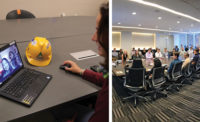SeeHerWork Engineers Women's Gear From the Ground Up

SeeHerWork makes construction gear in not just the right size, but also the correct proportions to fit female workers. CEO Jane Henry says women clamored for her prototype hand protectors.
PHOTO COURTESY SEEHERWORK

SeeHerWork makes construction gear in not just the right size, but also the correct proportions to fit female workers. CEO Jane Henry says women clamored for her prototype hand protectors.
PHOTO COURTESY SEEHERWORK

SeeHerWork’s bra for construction sites protects women workers from embers and debris.
PHOTO COURTESY SEEHERWORK



The founder of a company that’s designing construction equipment and clothing for women didn’t just walk a mile in their shoes—she’s logged days in their type of pants.
When Jane Henry had to gut her Houston home after Hurricane Harvey flooded it with 4 ft of water, mud and silt, she found that trousers meant for construction projects didn’t conform to her body properly, so she couldn’t safely bend or squat. Henry ended up wearing repurposed civvies that weren’t abrasion-resistant, and she’d constantly cut her legs.
“It infuriated me when I had to wear it on a day-to-day basis,” she says. Her experience—and that of female volunteers who tried to help her and others rebuild but didn’t fit into available personal protective equipment (PPE)—spurred the former energy company executive to launch SeeHerWork.
Rather than simply shrink men’s gloves, harnesses, clothes, respiratory masks, eye protection and other PPE, SeeHerWork designs items from scratch, so that the goods are proportionate to female hands, feet, faces and figures. Even compliant boots in women’s sizes—already made by Timberland, Redwing and others—pose a challenge, due to differing widths in relation to lengths, according to Henry.
Focusing on fit isn’t about vanity. “PPE must fit properly so that it can effectively protect the employee,” OSHA’s website says, and “should be based upon female [body measurement] data.” Mt. Sinai Selikoff Centers for Occupational Health, in a 2016 report, called many products “ ‘Barbie-fied’ work gear,” stylistically feminine but not fully functional.
Marilyn Ordonez, a project manger at Shawmut Design and Construction, knows the pain. “I landed a new project at LaGuardia [Airport], and there is a safety requirement for composite or steel toe boots, reflective vests or tops, and safety gloves needed daily. There is very little available. Even the gloves, I had to purchase a small in men’s since women’s sizes were unavailable.”
More somber are U.S. Bureau of Labor Statistics 2016 figures underscoring PPE’s importance. The construction industry accounted for 48% of all on-the-job fatalities. While it didn’t break down construction deaths by gender, across all industries, 387 women died: 11% due to falls and slips, 13% because of exposure to harmful substances or environments and 6% from fatal contact with objects.
SeeHerWork isn’t the first to focus on women. In 2010, ENR spotlighted boot and glove seller Woman Up (its website no longer functions) and North Carolina-based Charm and Hammer, which sells hard hats, hearing protection and other items by various manufacturers.
But SeeHerWork differs from these retailers because it develops and makes its own wares. Henry adds that she doesn’t have to worry about extra overhead that big manufacturers incur when redesigning products or modifying assembly lines from men’s to women’s products.
Henry’s items also stem from her personal in-depth research, whether chatting to shoppers in hardware stores or speaking to a company’s female workforce. She says women clamored for prototype gloves she sewed herself after others would bunch and interfere with her grip.
She’s also working with female roofers in Florida to develop safety harnesses. Even small ones currently on the market fit awkwardly between the legs and buckle uncomfortably over the chest, she says. Safety equipment will take more time to develop, Henry admits.
An engineer’s backpack that SeeHerWork will start selling when it launches in September may help solve one harness problem, with a front buckle that fastens just below the clavicle. Another item sounds like a superhero’s uniform: a sports bra-like undergarment that protects women from flying embers and falling debris.







